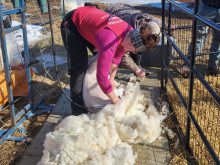BANFF, Alta.- Men might be able to travel to the moon, but back on Earth, weeds persist despite all the technology available.
“There is a battle between our control practices and the ability of weed communities to shift,” said Doug Buhler of Michigan State University, at a weeds meeting held on Nov. 28 in Banff.
He has worked extensively with researchers and farmers to implement integrated weed management. It is a management concept that includes cultivation, shifting seeding rates and times, fertilizer use and understanding weed biology.
Read Also

Charges laid after cattle theft
Saskatchewan RCMP lay two charges against a man after six cattle went missing.
Herbicides figure in the equation, but Buhler warns there is no sense hoping for a miracle chemical that will wipe out all weeds. It costs about $100 million (US) to develop a new product, so farmers are better off using the tools they already have.
The major problem in the battle against weeds is that they are complex and can adapt to a number of environments.
“We really create our own weed problems because weeds are taking advantage of the environment we created,” he said.
Farmers need to realize weed management and weed control are two different concepts.
Control is a single activity to remove weeds, but management uses a variety of strategies against problem plants.
Buhler described this as using “many little hammers rather than a big hammer.
“The idea isn’t to rid the world of weeds. We tried that and in most cases we haven’t been successful.”
Producers need a variety of strategies that include biological controls, cover and smother crops, and herbicide selection. They need to look at the competitive ability of farmed crops to tolerate weeds.
Producers need to understand more about weed seed dormancy, longevity of weed seeds, germination and timing of weed emergence.
Another problem created by farmers is bare soil. It is not a natural condition and there is consistent pressure in nature to fill the space.
The weed community is also extremely diverse. It is not unusual to find 30 weed species in a single field waiting for a chance to take hold.
Even after several years of burial, some seeds can still germinate and restart the cycle. Farmers need to understand how different species grow.
Grass species grow quickly at the beginning of the growing season, while broadleaf weeds come up later. They often push through the ground after spraying. They can thrive and spread if non-residual herbicides are used.
Some plants appear to be killed by a herbicide, but a new shoot comes up from the root and will survive long enough to produce seeds.
“Some of these have some pretty good mechanisms to survive and thrive under the current systems that are being used,” Buhler said.
Monoculture, limited rotation and continuous cropping make it harder to control weeds. Buhler recommends changing planting dates and rotating different crops in a field to outgrow the weeds.
This could include several years of summer annual crops followed by a perennial that chokes out weeds and does not disturb the seedbed so weeds cannot emerge.
Another idea is changing planting dates. Early spring or fall planting can also halt weed growth because the good plants are up and thriving before the weeds take hold.

















